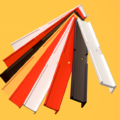Shelves are only as strong as the brackets that support them. There are many types of shelf brackets available, each designed for different needs and styles. Choosing the right bracket ensures your shelf is safe, sturdy, and looks great in your space. In this guide, we’ll break down the most common shelf bracket types and how to choose the best one for your project.
Woodworker Express offers a wide selection of shelf brackets from top brands like Federal Brace, Knape & Vogt, Sugatsune, and Reeve Equipment – all at low prices with excellent customer service. Whether you’re a DIY enthusiast or a professional carpenter, understanding these bracket types will help you find the perfect support for your shelves.

Standard L-Shaped Brackets (Angle Brackets)
Standard L-brackets are the most common shelf supports. They form a right angle with one side mounted to the wall and the other under the shelf. Most are steel or aluminum and come in various sizes to fit different shelf depths.
L-brackets are straightforward to install and provide reliable support for everyday shelving. For very heavy loads, heavy-duty L-brackets are available. These use thicker metal or reinforcements to provide extra strength. L-brackets are visible under the shelf, so they may be simple and utilitarian or have decorative touches.
Some have a small lip at the end to keep the shelf from sliding off. Use standard or heavy-duty L-brackets for general-purpose shelving in any room – from bookshelves in an office to storage shelves in a garage.

Decorative Shelf Brackets (Corbels)
When style is as important as strength, decorative shelf brackets are the way to go. These brackets combine support with visual appeal. They often have ornate designs or attractive finishes (wrought iron scrolls, decorative metal patterns, or carved wood corbels) that complement your decor.
Decorative brackets still provide good support for shelves, but they are chosen for their look. They usually mount the same way as standard brackets (with screws into the wall) but serve as a design element as well. You’ll find decorative brackets in modern geometric styles, vintage Victorian designs, rustic farmhouse looks, and more.
They are best for open shelves in living rooms, kitchens, or any space where the brackets will be on display. For example, a pair of decorative iron brackets can support a spice shelf in the kitchen while adding a touch of charm to the space.

Floating Shelf Brackets (Hidden Brackets)
If you want a clean, modern look with no visible hardware, floating shelf brackets are your choice. These brackets are hidden inside the shelf, making the shelf look like it “floats” on the wall.
A typical floating shelf bracket has metal rods or a thin supporting frame that you attach to the wall. The shelf slides onto these supports, hiding the bracket completely. This design means the hardware is invisible once the shelf is mounted. Floating brackets must be firmly anchored (ideally into wall studs) since they lack the extra bracing of external brackets. They also typically support less weight than standard brackets.
Use floating shelf brackets for light to medium-weight items in a living room, bedroom, or bathroom – for example, displaying small books, pictures, or collectibles. They give a sleek, open look to the space.

Specialty Brackets (Closet Rod, Corner, etc.)
Beyond the common types above, there are specialty shelf brackets designed for specific purposes:
- Shelf and Rod Brackets: These have an integrated hook or holder for a hanging rod beneath the shelf. They are perfect for closets, allowing you to support a shelf and hang a clothes rod for hangers with one bracket. Typically made of heavy-duty metal, they combine two functions in one.
- Corner Shelf Brackets: Designed for shelves that fit into a corner of a room (90° corner shelves). Some corner brackets are L-shaped pieces that support the triangular shelf from below, while others come as a pair to mount on each wall. They maximize storage in unused corner spaces.
- Pipe Brackets: In industrial or rustic designs, some people use plumbing pipes and flanges as shelf brackets. They function like L-brackets but give the aesthetic of exposed black iron pipes – great for a farmhouse or steampunk look.
- Folding Brackets: These hinged brackets let you fold a shelf down when it’s not needed. They are ideal for occasional-use surfaces, like a drop-down work table in a garage or a fold-away desk in a small room.
- Adjustable Track Systems: These use vertical rails on the wall with brackets you can move to different heights. This system lets you rearrange shelf spacing easily (commonly found in closets and pantries for flexible storage).
Use these specialty brackets when your project has unique requirements. For example, closet rod brackets are a must for closet organizers, corner brackets let you add a shelf in a tight corner, and folding brackets work well for multi-purpose spaces. Always ensure the bracket type you choose is rated to support the weight of your shelf and items.
Shelf Bracket Types Comparison Chart
The table below compares key characteristics of the main types of shelf brackets to help you decide which suits your needs:
| Bracket Type | Key Features | Ideal Use |
|---|---|---|
| Standard L-Bracket | – Right-angle, visible bracket (metal) – Simple, sturdy, easy to install – Available in light-duty and heavy-duty versions for different weight needs | General-purpose shelves in any room (books, dishes, storage). Choose heavy-duty versions for heavier items or garage storage. |
| Decorative Bracket | – Ornate or decorative design (metal or wood) – Enhances shelf appearance; also provides sturdy support for moderate loads | Open shelves in living areas or kitchens where the brackets add to the decor. Great for displaying collectibles, plants, or dishware. |
| Floating Bracket | – Hidden inside shelf for a “floating” look – Invisible once installed; lower weight capacity than other types | Modern, minimalist displays of light items. Best for clean look in living rooms, bedrooms, or bathrooms (e.g. small photo frames, candles). |
| Specialty Brackets | – Special-purpose designs (closet rod combos, corner brackets, folding, etc.) – Made for specific functions or styles (e.g. industrial pipe look) | Closets (shelf + hanging rod), corner shelves, fold-down tables, or other unique applications where standard brackets aren’t suitable. |
The Woodworker Express Advantage
When shopping for shelf brackets, Woodworker Express is your one-stop source. We carry all the bracket types above in a wide variety of sizes and finishes, from top brands like Federal Brace, Knape & Vogt, Sugatsune, and Reeve Equipment (known for quality and durability). We offer competitive prices on all our shelf hardware, so you can get what you need without breaking the budget. Not sure which bracket to choose? Our knowledgeable customer service team is ready to guide you to the right product and ensure your order arrives quickly and safely.
Ready to get started? Explore our shelf brackets selection on Woodworker Express to find the perfect brackets for your next project!
Want to dive deeper into the world of shelf hardware? Read our Ultimate Guide to Shelf Hardware on the Woodworker Express blog.
Frequently Asked Questions about Shelf Brackets
Q: How much weight can a shelf bracket hold?
A: It depends on the type and size of the bracket, and how it’s installed. A standard metal L-bracket might hold around 20–50 lbs per pair when properly mounted into wall studs. Heavy-duty brackets can support 100 lbs or more each. Always check the manufacturer’s weight rating and mount brackets into solid wood or studs for maximum strength.
Q: How do I choose the right size bracket for my shelf?
A: Choose a bracket that is slightly shorter than the shelf depth. As a rule of thumb, the bracket arm should cover at least two-thirds of the shelf’s depth. For example, for a 12-inch deep shelf, use a bracket around 8–10 inches long. If the bracket is too short, the shelf could sag or tip. If it’s too long, it might stick out past the shelf edge.
Q: How many brackets do I need for a shelf?
A: You need at least two brackets for any shelf – one at each end. For longer shelves, add a third bracket in the middle for extra support. A good guideline is a bracket about every 24–36 inches. For instance, a 4-foot shelf should have three brackets (one at each end and one in the center). When in doubt, add an extra bracket for safety.
Q: Do I need to attach shelf brackets to wall studs?
A: For the strongest installation, it’s best to mount shelf brackets into wall studs. Studs (the wooden framing behind drywall) will support a lot of weight. If you can’t hit a stud where you want a bracket, use a heavy-duty wall anchor appropriate for your wall type. Keep in mind that the weight capacity will be lower when using anchors. Whenever possible – especially for heavy shelves or floating shelf supports – secure brackets into studs.


